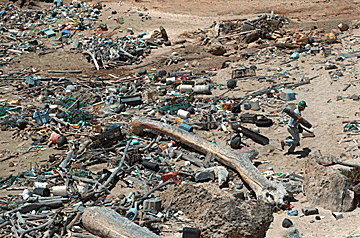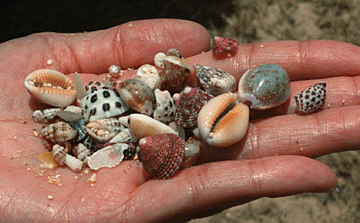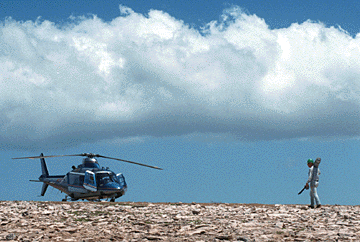


A taste
of the forbidden
Keith Robinson of the Niihau Robinson family recently allowed Star-Bulletin writer Catherine Enomoto and staff photographer Ken Ige to visit the private island where few outsiders are allowed.Stories by Catherine Kekoa Enomoto
Photographs by Ken Ige
Star-BulletinFROM the 1,200-foot-high shorn-away volcano on its eastern face to the tiniest rare and valuable shells on its western shore, Niihau is a remote island of simple natural beauty. The isle is about a 15-minute helicopter ride from Port Allen. As the chopper approaches Niihau, the island's profile resembles a mahimahi with a high square forehead pointing right, its body tapering left. A closer view reveals low plains sweeping down on both sides.
The high, central cliff mass is one-half of a volcano crater, whose other half is submerged in the ocean. Visible along the crater face are lava trails and ridges, many worn smooth from wind and wave action.
At the north tip of Niihau reposes Lehua island, a crescent-shaped crater rising out of the sea.
This day the helicopter circles Niihau slowly, scoping out vestiges of a half dozen fishing-hunting cottages of the Robinson family, which owns the island. A few military outposts, radar facilities and other widely scattered building ruins relieve the semi-desert scape. The ubiquitous kiawe twists in long clumps over the ground and rises in tufts like banshees' gray hair standing on end.

The chopper lands near Kawaihoa, a cinder cone on the southern tip of the island. No human-made edifices distract from the colors, textures, diversity and wonder of nature. The serene, austere environment magnifies one's senses to the environment's simple offerings.Breezes waft over the dry, sunny landscape. Gold and blue Pa'u O Hi'iaka blossoms peek amid the white shale crunching underfoot. The tide pools taste brackish.
Along the coastline are chalky rocks streaked with rust and lava stalagtites formed by the incessant crash of waves. The sea growls and swooshes against the cliffs. Sea spray teases and tickles one's skin.
A red cardinal and orange birds chatter in the kiawe. Amid the shale lie green tufts of hinahina, or beach heliotrope, and bleached droppings of sheep -- like handfuls of white raisins.
Sea detritus -- the garbage of modern living -- is scattered along Keanahaki Bay in piles chronicled in bygone news photos. The array includes a laundry board, ship's ropes, nets, Styrofoam floats, a Spam can, massive logs and plastics objects in shades of blue, turquoise, yellow, orange, black and brown. Fisher's glass balls hide amid the detritus -- seven are found this day.
Farther down the beach, two slumbering Hawaiian monk seals loll in the surf. They lift their heads occasionally to stretch a neck muscle or check each other's location and two staring humans.

A pile of 'opihi shells documents a recent finders-keepers feast. Beside the bay yawns a 6-by-10-foot cave, once servants quarters when the Robinsons stayed at a hunting lodge -- now lying in ruins nearby.Then, the helicopter heads west for Nonopapa, site of a once-busy sheep-shearing corral. The chopper passes over bleached branches of a dead breadfruit tree, standing in a sinkhole half surrounded by a low stone wall. (Niihauans traditionally planted breadfruit and sweet potatoes in sinkholes, possibly to deflect winds; that is the only example apparent.)
The western shoreline is a series of coves, headlands, reefs, white sand beaches and increasingly shallower bays.
At Nonopapa, warm winds kick up, howling across the 18-mile-long isle that's shaped like the monk seal that inhabits its shores. The minty-lavender fragrance of kokokahakai (vitex, a beach herb) scents the solitary beach streaked with horse-hoof marks, seal burrowings and the tiny, multicolored columbella known as rare Niihau shells. It's thrilling for a city dweller to crawl on hands and knees and in every scoop, find a dozen wonderful shell gems.
One slakes one's thirst with cool water and sits beneath ironwood pines while contemplating the sweep of azure sky and gray-green ocean. A fishing boat is anchored offshore, its body rolling in the stronger winds.
Next, the chopper flies inland and steers clear, for privacy reasons, of the Niihauans' village at Pu'uwai. A dozen amber buildings are visible in the distance.
The chopper buzzes over muddy brown lakes and reservoirs, some with cattle knee deep in water, and a dozen Arabian horses dancing in a large, fenced corral. A family of four black feral pigs prances along a bay. Further are the remains of a heiau, black rock outcroppings and more kiawe.
At Nanina in the North, seven people -- four adults, a girl about 10 years old and two preschool-aged boys -- lean against a white Humvee. They look like a local family from Nanakuli, Waimanalo or Papakolea. The men wear jeans and cowboy hats and boots. The children are barefoot and wear cotton shorts and shirts. An older woman carries a hand-held radio that looks like a large cell phone.
The Niihau tour is curtailed to medevac Lindsey Kelley to Kauai. He was stapling fence wire and a misfired staple hit near his eye.
The chopper takes on Kelley's family of four. The full cabin is warm and close; the whir of helicopter propellers is deafening; the smell of diesel fuel is slightly nauseating.
Over the earphones, passengers hear Keith Robinson's comforting words to Kelley: " 'A'ole rub" (Don't rub) and something about "maka'ani'ani" (eyeglasses).
The return trip is anxious because the helicopter's speed drops when the chopper flies into 30 mph winds across the Kaulakahi Channel. (Kelley later underwent immediate surgery at a Waimea clinic and his vision was saved.)
A passenger glances back at the receding volcano remnant on the isle's eastern face, and a Hawaiian proverb comes to mind about this remote place of enduring language, culture, spirit and beauty:
"Ni'ihau i ke kiku." Niihau leans back firmly.
It means: Niihau people are independent.
The Robinson family owns Niihau, much like you own your house and plot of land. And as you invite people to your home, so the Robinsons control access to the island; you need an invitation to go there. Privileged few view
by invitation onlyThe state Attorney General's office says, however, that the island's shoreline is public up to the vegetation line, which is defined as the highest reach of waves during normal high tides.
Keith Robinson refutes that assertion. He says his forebears bought Niihau in 1864 under the Hawaiian monarchy and they never relinquished the island's konohiki (chiefly) rights written in the monarchy deeds.
Such private-property rights, granted during the monarchy, extend to submerged lands below the beach.
Moreover, Robinson said Niihau is a federally registered endangered-species habitat for up to 90 Hawaiian monk seals, which are shy of humans and easily scared off.
The Kauai Police Department says it will arrest only trespassers who go above the vegetation line.
If you'd like to get to go on Niihau, you may want to either get permission or take a helicopter tour.
To seek permission, fax a written request to Bruce Robinson, Niihau Ranch, 1-808-338-1463.

If you have enough money, you can get to Niihau on a helicopter tour or a hunting safari. Helicopter tours available
The Niihau Helicopter Inc. tour flies visitors over the island, with views of rare Hawaiian monk seals, wild pigs and sheep. For the privacy of residents, the craft does not pass over Pu'uwai village.
The helicopter touches down at Nanina on the north coast where visitors may swim, sun, explore, gather shells, photograph and picnic.
Tours are 9 a.m. to 1:30 p.m. six days a week. Cost is $250 per person, based on groups of four or five; groups can be arranged.
The Niihau Safari offers a hunting license, gun, guide, two skinners, ground transportation and lunch. There's a guarantee of two quarries -- any combination of sheep and wild pig.
Safaris are from 6:30 a.m. to 5 p.m. six days a week. Cost is $1,500 per person, based on one to four in a party.
For an informational flier on the tour or safari, call 1-808-335-3500.
Also, a Hyatt Regency Kauai tour package includes snorkeling gear and lunch. Information: 1-808-742-1234.
Niihau
Owner: Helen Robinson, 86; managed by Bruce Robinson, 54, her younger son, who along with brother Keith, 56, is heir to the island.
Size: 18 miles long by 6 miles at the widest point; 69.5 square miles or 44,455 acres. (The Robinson family's holdings on Niihau and Kauai place it among Hawaii's top five land owners with 101,029 acres in fee.)
Location: 17.2 miles across the Kaulakahi channel from west Kauai
Population: 230 (1990 census); currently 150 to 200 people, depending on vacations, sickness, gatherings on Kauai and trips, as to Las Vegas. Niihauans have recurring surnames of Beniamina, Kanahele, Ka'ohelauli'i, Keale, Kelley, Niau, Niheu and Shintani. (Ishimatsu Shintani, born in Japan, went to work on Niihau in 1910, married a Hawaiian woman and remained there after her death. In 1960, he became Niihau's first alien to gain U.S. citizenship.)
Major community: Pu'uwai, in west-central Niihau
Commercial enterprise: Cattle, helicopter tours, hunting safaris, Niihau shell jewelry
Military involvement: Navy maintains an unmanned radar facility on the island
Utilities: Homes have electrical generators, and some televisions and VCRs although live TV reception is bad; there are no
telephones.
Weather: Warm, windy, semi-arid; similar to Oahu's weather, except with more temperature extremes -- ranging from 42 to 110 in the shade
Fresh water source: Rain -- 60,000 gallons used daily, half each for domestic uses (from catchment) and agricultural uses (from lakes)
Terrain: About three-fourths of the island is gently undulating semi-desert, most of it a kiawe-dotted plain 50 to 100 feet above sea level
Highest peak: Paniau, 1,250 feet
Lowest point: Halulu Lake, 2 feet below sea level; lowest point in the state of Hawaii
Major lakes: Halalii Lake, 865 acres -- Hawaii's largest lake
Major beach: Keawanui, 3.5 miles long -- Hawaii's second longest beach after Waimanalo Beach
Major bays (clockwise from north end): Keamano, Kalaoa, Keanahaki, Kaumuhonu, Yam and Keawanui
Historical figure: Chief Kahelelani
Island emblem: Niihau shell
Island color: White
Heiau: The remains of Kaunuapua heiau at Kihawahine are an estimated 50 feet long, located on the beach near Palikoae at the northwest end of the island.
Page 1 | Page 2 | Page 3 | Page 4